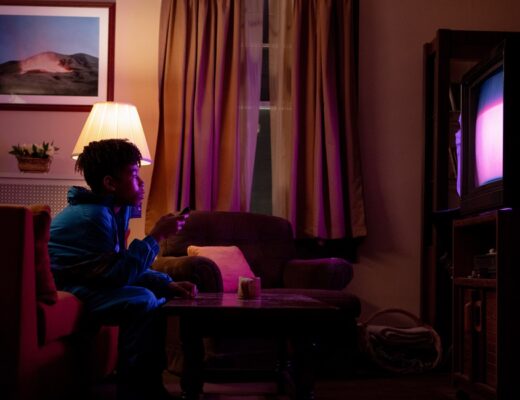Louis Wain has one distinctly lovely stretch, but it’s shrouded in pervasive busyness and zaniness that ultimately sinks the whole enterprise.
Will Sharpe’s The Electrical Life of Louis Wain opens with Benedict Cumberbatch, heavily pancaked in old-age make-up, manically dancing in a way that immediately recalls Grandpa Joe’s miraculous recovery sequence in Willy Wonka and the Chocolate Factory. There’s a familiarity to the theatricality at play here that instantly invites feelings of both intrigue and dread: What is Cumberbatch up to now? As the soothing voice of Olivia Colman fills the speakers, her voiceover narration a mixture of matter-of-fact backstory and sassy asides, one prepares for what is sure to be a hearty slice of whimsy, and to that point, The Electrical Life of Louis Wain does not disappoint.
In chronicling the life of the eponymous artist, Sharpe opts for stylistic excess above all else, a direction which is unsurprising considering the film’s subject. Best known for his drawings of large-eyed cats, Louis Wain became something of a sensation in early 20th-century London, his playful works inspiring wonder and admiration, and ushering in a wave of feline domestication that made cat ownership not only socially acceptable, but indeed normal. But Electrical Life begins several years before all this cat chicanery, focusing on Louis’s life as a thirty-something struggling artist trying to make ends meet for his widowed mother and five spinster sisters, all of whom live under the same roof. But Wain was not only an artist; he also fancied himself a boxer, an opera composer, and an inventor specializing in areas of electricity, although he found little to no success in those pursuits. And while the multi-hyphenate lived and worked before the terminology even existed, it’s made quite obvious here that Wain falls somewhere on the Autism Spectrum, which Sharpe and co-writer Simon Stephenson use as an excuse to engage in a number of comedic set pieces where Wain’s general awkwardness when it comes to social norms is continuously used as a punchline, especially in his pursuit of a romance with newly-hired governess Emily Richardson (Claire Foy).
If that sounds more than a little gross, it is, and the first half-hour of Electrical Life is by far its worst, with each character existing as nothing more than a series of obnoxious tics, broadly played by a cast that is trying far too hard, including Andrea Riseborough as one the Wain sisters, who is nothing more than a pinched, ghostly face and a scornful demeanor. Yet once Louis and Emily get married and move into their own house, something surprising occurs: for the next 30 minutes, the film takes a breather from its exhausting freneticism and enters into its own form of contented domestication, affording both Cumberbatch and Foy the opportunity to find the humanity within their zany characters. It’s a truly lovely stretch, one that comes to a screeching halt with the death of one character and the reappearance of the Wain clan.
It’s also at this point that the film changes its focus to Louis’s deteriorating mental health, affording Sharpe the opportunity to engage in visual overkill, with cat visages replacing human heads, and the screen morphing into a kaleidoscope of multi-colored feline faces for two trippy minutes. Researchers have long contended that Wain suffered from schizophrenia, his condition worsening as he got older; however, this theory has become controversial, as modern-day psychologists believe such a diagnosis is not only impossible to determine, but also suggest that his later work virtually refutes such claims. Electrical Life never outright states Louis’s diagnosis as such, but Sharpe leans heavily into this implication on a stylistic level, which feels both irresponsible and reductive (if not outright offensive). That’s not to say that Sharpe is a terrible director; his penchant for and facility with candlelight and natural lighting is not only aesthetically pleasing here, but it has the effect of rendering his compositions to resemble oil paintings come to life, a suggestion which becomes literal in a breathtaking mid-film shot with Louis, Emily, and their cat that plays like an homage, oddly enough, to Vincent Ward’s What Dreams May Come. One just wishes Sharpe would have dialed down the busyness a tad more consistently, as Electrical Life ultimately wears out its welcomes long before the end credits. It’s an exhausting film, one that trafficks in death, mental illness, poverty — but also cute cats. The film’s irony won’t be lost on many, but it too is so obnoxiously rendered as to only grate. Save your time and watch some cat videos on YouTube instead; they are far more electrifying than anything in this Life.
You can catch Will Sharpe’s The Electrical Life of Louis Wain in theaters on October 22 or streaming on Amazon Prime Video beginning on November 5.







